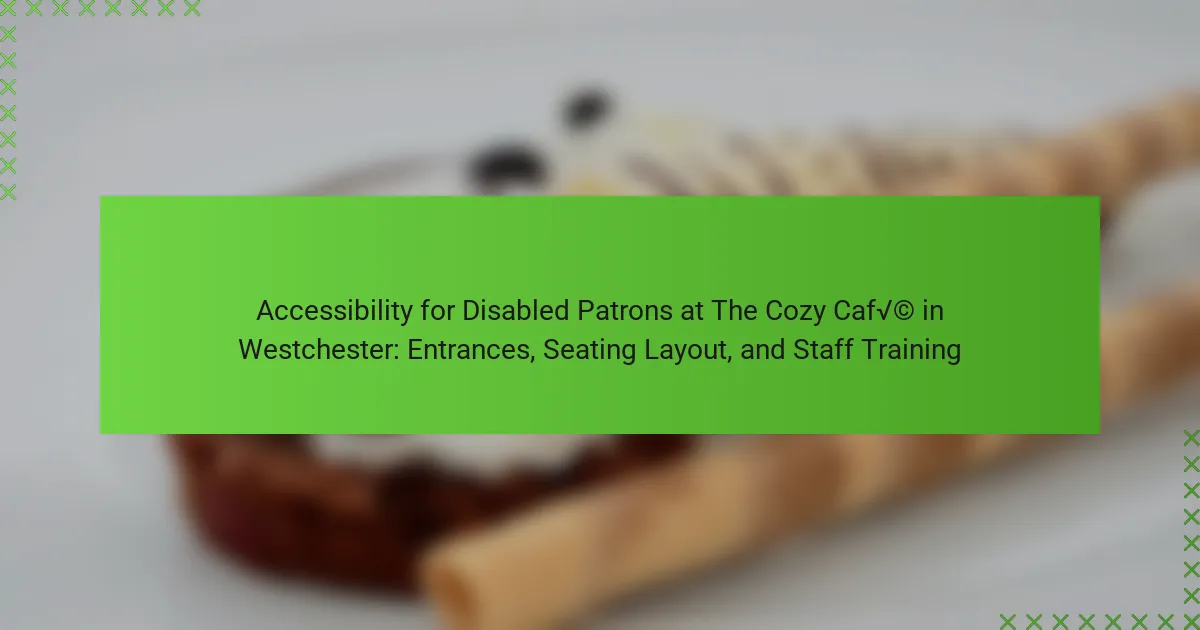
What is Accessibility for Disabled Patrons at The Cozy Café in Westchester?
Accessibility for disabled patrons at The Cozy Café in Westchester includes features designed to accommodate various needs. The café has wheelchair-accessible entrances and pathways. Seating arrangements are designed to allow easy movement for patrons with mobility aids. Staff members receive training on assisting disabled guests effectively. Accessible restrooms are available for patrons requiring additional support. The café prioritizes creating an inclusive environment for all customers. These measures ensure that disabled patrons can enjoy their experience without barriers.
Why is accessibility important for cafés like The Cozy Café?
Accessibility is important for cafés like The Cozy Café to ensure all patrons can enjoy their services. It allows individuals with disabilities to enter, navigate, and utilize the café without barriers. Accessible features include ramps, wide doorways, and appropriate seating arrangements. These modifications enhance the overall customer experience. According to the Americans with Disabilities Act (ADA), businesses must provide reasonable accommodations. This compliance not only avoids legal issues but also fosters inclusivity. Research shows that accessible venues can increase customer loyalty and patronage. Therefore, accessibility is both a legal requirement and a business advantage for cafés.
What are the legal requirements for accessibility in dining establishments?
Dining establishments must comply with the Americans with Disabilities Act (ADA) for accessibility. This law mandates that restaurants provide accessible entrances, restrooms, and seating. Entrances must have ramps or automatic doors for wheelchair access. Restrooms must be equipped with grab bars and sufficient space for maneuverability. Dining areas must include accessible seating options. Staff training is required to assist disabled patrons effectively. Non-compliance can result in legal action and fines. The ADA regulations ensure equal access for all customers, promoting inclusivity in dining experiences.
How does accessibility enhance the customer experience?
Accessibility enhances the customer experience by ensuring that all patrons can comfortably navigate and utilize services. This inclusivity fosters a welcoming environment for everyone, regardless of ability. Accessible features, such as ramps and designated seating, allow disabled patrons to enjoy the café without barriers. Studies show that businesses with better accessibility attract more customers, leading to increased revenue. For instance, a report by the American Institutes for Research indicates that improving accessibility can increase customer satisfaction and loyalty. Overall, enhancing accessibility directly contributes to a positive customer experience.
What specific accessibility features are available at The Cozy Café?
The Cozy Café offers several specific accessibility features. The entrance is wheelchair accessible with ramps and automatic doors. Inside, there are wide aisles to accommodate mobility devices. The seating layout includes designated spaces for wheelchairs. Staff members are trained to assist patrons with disabilities. Braille menus are available for visually impaired customers. Accessible restrooms are equipped with grab bars and enough space for maneuverability. These features ensure a welcoming environment for all patrons.
What types of entrances are provided for disabled patrons?
The Cozy Café provides multiple types of entrances for disabled patrons. These include wheelchair-accessible ramps and automatic sliding doors. The ramps are designed to meet ADA standards, ensuring a gentle slope for easy navigation. Automatic doors facilitate seamless entry without requiring physical effort. Additionally, there are designated entry points that are clearly marked for accessibility. These entrances enhance the overall experience for disabled patrons, promoting inclusivity. The café regularly reviews and updates its accessibility features to comply with current guidelines.
How is the seating layout designed to accommodate various needs?
The seating layout at The Cozy Café is designed to accommodate various needs by providing flexible arrangements. This includes movable tables and chairs to create space for wheelchairs. Additionally, there are designated areas that ensure easy navigation for patrons with mobility challenges. Aisles are kept wide to allow for comfortable passage. The café also incorporates different seating heights to cater to diverse preferences. Furthermore, the layout considers sightlines for patrons with visual impairments. These design elements collectively enhance accessibility and inclusivity for all guests.

How does The Cozy Café ensure accessibility through its entrances?
The Cozy Café ensures accessibility through its entrances by implementing features that accommodate all patrons. The main entrance is equipped with automatic doors for easy access. Additionally, the café provides ramps for wheelchair users. The entrance area is designed to be spacious, allowing for smooth navigation. Clear signage indicates accessible pathways. Staff are trained to assist patrons with mobility challenges. These measures comply with ADA standards, ensuring a welcoming environment for everyone.
What are the key features of the café’s entrances?
The key features of the café’s entrances include wheelchair accessibility, automatic sliding doors, and tactile paving. Wheelchair accessibility ensures that patrons with mobility challenges can enter easily. Automatic sliding doors provide a hands-free option for those who may struggle with traditional door handles. Tactile paving assists visually impaired individuals in navigating the entrance safely. Additionally, the entrances are designed to be wide enough to accommodate mobility aids. Clear signage indicates accessible routes and features. These elements collectively enhance the overall accessibility of the café for disabled patrons.
How wide are the doorways, and are they wheelchair accessible?
The doorways at The Cozy Café in Westchester are 36 inches wide. This width meets the standard requirements for wheelchair accessibility. Additionally, the café has designed all entrances to accommodate wheelchair users. The layout ensures that patrons with mobility challenges can access all areas comfortably. Compliance with the Americans with Disabilities Act (ADA) guidelines confirms the café’s commitment to accessibility.
Are there ramps or automatic doors available at the entrances?
Yes, there are ramps and automatic doors available at the entrances. The ramps provide easy access for individuals with mobility challenges. Automatic doors ensure a hands-free entry experience. These features comply with accessibility standards. They enhance the overall experience for disabled patrons. The Cozy Café prioritizes inclusivity in its design.
How does the entrance design impact disabled patrons?
The entrance design significantly impacts disabled patrons by determining their ease of access. A well-designed entrance includes features such as ramps, automatic doors, and wide pathways. These elements facilitate smooth entry for individuals using wheelchairs or mobility aids. According to the Americans with Disabilities Act (ADA), entrances must be accessible to ensure equal access. Poorly designed entrances can create barriers, leading to frustration and exclusion for disabled individuals. Research shows that accessible entrances increase patronage and satisfaction among disabled customers. Thus, thoughtful entrance design is crucial for enhancing accessibility at The Cozy Café.
What challenges might disabled patrons face when entering the café?
Disabled patrons may face several challenges when entering the café. Physical barriers such as stairs or narrow doorways can impede access. Inadequate ramps or lack of automatic doors can create difficulties for those using wheelchairs or mobility aids. Additionally, uneven surfaces or obstacles near the entrance may pose risks of tripping. Insufficient signage indicating accessible routes can lead to confusion. Limited space inside the entrance may hinder movement for patrons with disabilities. Lastly, untrained staff may not assist effectively, further complicating the entry experience for disabled individuals.
How can improved entrance accessibility benefit all customers?
Improved entrance accessibility benefits all customers by creating a more inclusive environment. Accessible entrances allow individuals with mobility challenges to enter without barriers. This design also streamlines entry for parents with strollers and elderly customers. Enhanced accessibility can reduce wait times as everyone can enter more efficiently. A welcoming atmosphere encourages repeat business from all patrons. Studies show that inclusive spaces lead to increased customer satisfaction. Overall, improved accessibility fosters a sense of community and belonging for everyone.

What role does seating layout play in accessibility at The Cozy Café?
Seating layout at The Cozy Café is crucial for accessibility. It determines the ease with which patrons with disabilities can navigate the space. A well-planned layout allows for wheelchair access and movement between tables. Sufficient space between seating areas ensures that individuals with mobility aids can maneuver comfortably. The arrangement of furniture should avoid creating obstacles that hinder access. Accessible seating options are essential for accommodating diverse needs. Compliance with accessibility standards enhances the café’s inclusivity. This commitment to accessibility can attract a broader customer base.
How is the seating arranged to support disabled patrons?
Seating at The Cozy Café is arranged to accommodate disabled patrons by ensuring ample space for mobility devices. Tables are placed with sufficient clearance to allow wheelchair access. Additionally, designated seating areas are available for patrons with disabilities. These areas are strategically located near entrances for convenience. Staff members are trained to assist with seating arrangements as needed. Clear signage indicates accessible seating options. This arrangement complies with ADA standards for accessibility.
What types of seating options are available for different needs?
The types of seating options available for different needs include standard chairs, accessible tables, and specialized seating. Standard chairs are common in cafés and provide basic seating. Accessible tables are designed to accommodate wheelchairs and provide ample space for mobility. Specialized seating includes options like benches, stools, and lounge chairs, catering to various comfort preferences. Each seating type is essential for ensuring inclusivity. Research indicates that inclusive seating enhances the dining experience for all patrons. Providing diverse seating options meets the requirements of the Americans with Disabilities Act (ADA), promoting accessibility for individuals with disabilities.
How does the layout facilitate movement for patrons with mobility aids?
The layout facilitates movement for patrons with mobility aids by ensuring wide pathways and clear access points. Pathways measure at least 36 inches in width, allowing easy navigation for wheelchairs and walkers. Tables are arranged to provide ample space between them, preventing obstacles. The layout includes ramps at entrances, complying with ADA standards for accessibility. Signage is positioned at eye level to assist in navigation. Additionally, seating areas are designed with lower tables to accommodate various mobility aids. This thoughtful design enhances the overall experience for patrons with mobility challenges.
What considerations are taken into account for seating accessibility?
Seating accessibility considerations include wheelchair space, seat height, and clear pathways. Wheelchair space must accommodate turning radius and maneuverability. Seat height should allow easy transfer from wheelchairs. Clear pathways ensure safe navigation for patrons with mobility aids. Accessible seating should be integrated into the overall layout. Compliance with ADA guidelines is essential for legal standards. Staff training on accessibility needs enhances service quality. These factors collectively improve the experience for disabled patrons.
How does the café ensure adequate space between tables?
The café ensures adequate space between tables by following specific layout guidelines. These guidelines adhere to accessibility standards, allowing for easy navigation. Tables are positioned to maintain a minimum distance of 36 inches apart. This spacing accommodates wheelchair users and patrons with mobility aids. The café regularly reviews its seating arrangements to ensure compliance with these standards. Staff members are trained to adjust table placements as needed. This practice promotes a comfortable dining experience for all patrons.
What feedback mechanisms are in place to improve seating arrangements?
The Cozy Café implements several feedback mechanisms to improve seating arrangements. These include customer surveys that specifically ask for input on seating comfort and accessibility. Staff training emphasizes the importance of gathering verbal feedback from patrons during their visit. Additionally, suggestion boxes are placed throughout the café for anonymous feedback. Regular meetings are held to review feedback and discuss potential improvements. This systematic approach ensures that seating arrangements are continuously evaluated and adjusted based on patron needs.
How is staff training conducted to support accessibility?
Staff training to support accessibility is conducted through structured programs. These programs educate staff about the needs of disabled patrons. Training includes understanding various disabilities and their impacts on customer experience. Role-playing scenarios are often used to simulate interactions with disabled individuals. Staff learn to communicate effectively and respectfully with all patrons. Accessibility features of the café are highlighted during training sessions. Regular refreshers and updates ensure staff stay informed about best practices. This approach fosters an inclusive environment for everyone.
What topics are covered in staff training related to accessibility?
Staff training related to accessibility covers various essential topics. These include understanding disabilities and their impacts. Staff learn about legal requirements such as the Americans with Disabilities Act (ADA). Training also addresses effective communication strategies with disabled patrons. Additionally, staff are educated on physical accessibility features like ramps and seating arrangements. Sensitivity training to foster an inclusive environment is another key area. Emergency procedures for assisting disabled individuals are included as well. These training components ensure that staff can provide a welcoming and accommodating experience for all patrons.
How does staff training improve the overall experience for disabled patrons?
Staff training improves the overall experience for disabled patrons by enhancing staff awareness and responsiveness. Trained staff can identify and accommodate specific needs effectively. This includes understanding mobility challenges and providing appropriate assistance. Training also fosters empathy, allowing staff to interact positively with disabled patrons. Enhanced communication skills lead to clearer interactions, reducing misunderstandings. According to a study by the National Center on Accessibility, trained staff significantly increase satisfaction among disabled customers. The study found that 85% of patrons reported better experiences in establishments with trained staff. Thus, effective staff training directly correlates with improved service quality for disabled patrons.
What best practices can be implemented to enhance accessibility at The Cozy Café?
Implementing best practices to enhance accessibility at The Cozy Café includes ensuring barrier-free entrances. All entry points should have ramps and automatic doors. The seating layout must accommodate wheelchairs and allow for easy movement. Tables should be accessible in height and spacing. Staff training is crucial for understanding and assisting disabled patrons. Regularly reviewing accessibility features can help identify areas for improvement. Compliance with the Americans with Disabilities Act (ADA) standards can guide these enhancements. These measures create a welcoming environment for all customers.
The main entity of the article is The Cozy Café in Westchester, specifically focusing on its accessibility features for disabled patrons. The article provides a comprehensive overview of the café’s entrances, seating layout, and staff training initiatives aimed at ensuring an inclusive environment. Key aspects include wheelchair-accessible entrances, appropriate seating arrangements, and trained staff to assist disabled guests effectively. Additionally, the article discusses the legal requirements under the Americans with Disabilities Act (ADA) and emphasizes the importance of accessibility in enhancing the overall customer experience.
